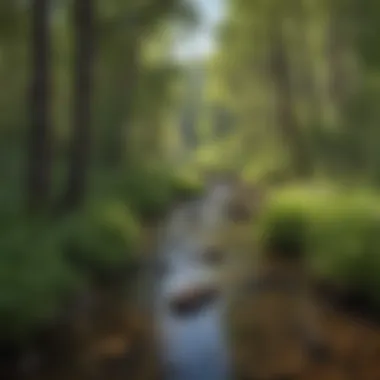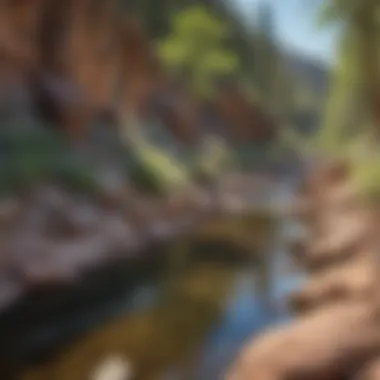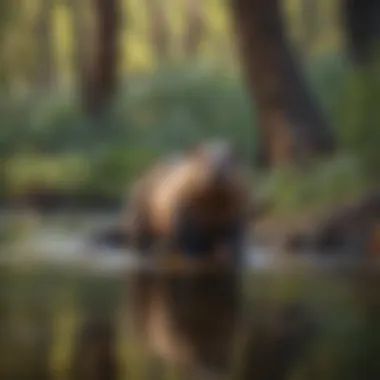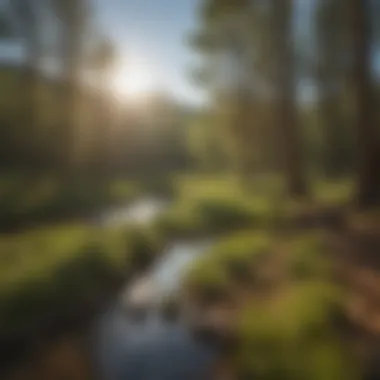Exploring Beaver Creek, Arizona: A Natural Haven


Intro
Nestled in the heart of Arizona, Beaver Creek stands as a testament to nature's beauty and ecological significance. This area is not just a landscape filled with scenic views; it represents a delicate ecosystem thriving with life. Understanding the intricate balance within this woodland is crucial, not only for enthusiasts but for professionals looking to preserve its unique character. The diverse flora and fauna contribute to a rich tapestry of biodiversity, acting as critical players in climate regulation and habitat stability.
As one delves into this guide, it becomes clear that the exploration of Beaver Creek encompasses more than just a stroll through the woods. It demands an appreciation for the historical context, the present ecological challenges, and the sustainable practices that can and should define its future. In a world increasingly shaped by human intervention, fostering a connection between local communities and their environment is more vital than ever.
Through the sections that follow, readers will encounter the various aspects of Beaver Creek’s natural ecosystem: the importance of biodiversity, sustainable forestry practices, and techniques for effective woodland stewardship. Each element plays a distinct role in highlighting how colonial history and modern conservation initiatives intertwine to shape our understanding and appreciation of this area.
Understanding these dynamics not only enriches the narrative surrounding Beaver Creek but also illuminates the path forward toward a healthier, more sustainable environment for generations to come.
Understanding Woodland Ecosystems
Woodland ecosystems, especially those like Beaver Creek, are dynamic webs of life that encompass a variety of interactions among plants, animals, and the physical environment. A closer look reveals the intricate relationships and dependencies that exist, all carefully balanced to maintain ecological integrity.
Importance of Biodiversity in Forests
Biodiversity acts as the backbone of woodland ecosystems. A rich variety of species ensures resilience against diseases, invasive species, and changing climate conditions. The forests are home to a myriad of plants, insects, birds, and mammals, each playing unique roles.
- Wildflowers: Provide food for pollinators.
- Trees: Contribute to soil stability and carbon sequestration.
- Predators: Help regulate herbivore populations.
Without these interconnected relationships, the ecosystem could falter. Furthermore, the genetic diversity within species is essential for adapting to new challenges, whether they arise from environmental changes or human impact.
Role of Forests in Climate Regulation
Forests serve a pivotal role in mitigating climate change. They act as significant carbon sinks, absorbing carbon dioxide from the atmosphere and helping to regulate temperatures. Notably, Beaver Creek plays its part in this larger narrative.
- Trees absorb CO2 through photosynthesis.
- Healthy forests reduce the buildup of greenhouse gases.
- Woodlands influence local climate patterns, impacting rainfall and temperature.
By understanding these mechanisms, forestry professionals can appreciate the critical need to manage and conserve these areas, ensuring that they continue to function effectively into the future.
"Healthy ecosystems are vital for both our environmental and social well-being. Conservation efforts should prioritize the promotion of biodiversity to sustain these essential services."
Sustainable Forestry Practices
As humanity grapples with the ramifications of overexploitation and habitat degradation, sustainable forestry practices emerge as a solution for the future. Focusing on methods that ensure ecological balance allows for thoughtful harvesting of resources without compromising habitat integrity.
Principles of Sustainable Forestry
Sustainable forestry hinges on several key principles:
- Maintain Species Diversity: Preserving a variety of trees and plants enhances resilience.
- Protect Water Resources: Proper management ensures that waterways are not polluted and remain protected.
- Ensure Regeneration: Active replanting and nurturing young trees are crucial for forest longevity.
By following these principles, professionals can help ensure that forestry activities are not only economically viable but also environmentally sound.
Case Studies of Successful Implementations
Several successful case studies exemplify how sustainable forestry practices can be effectively put into action:
- Pacific Northwest Thinning Projects: Selective thinning enhances growth while reducing fire risk.
- Swedish Forest Management: Integrating biodiversity considerations in timber production.
- Community Conservation Programs in Canada: Indigenous-led initiatives balancing cultural heritage and ecological health.
These examples illustrate the practical application of principles for managing resources responsibly and sustainably, underscoring the importance of community involvement and stakeholder engagement.
Woodland Stewardship Techniques
Effective woodland stewardship is crucial in maintaining the health and vibrancy of ecosystems like Beaver Creek. Various techniques can be deployed to manage forests sustainably and ensure they continue to thrive.
Forest Management Plans
A well-structured forest management plan acts as a roadmap for sustainable practices. These plans should include:
- Assessment of Current Conditions: Understanding the existing flora and fauna and their interdependence.
- Setting Long-term Goals: Clear objectives that guide conservation efforts.
- Monitoring and Adaptive Management: Regular reviews to adapt strategies based on evolving data.
Conservation Strategies


Adopting effective conservation strategies can enhance woodland health. Strategies may include:
- Controlled Burns: Utilizing fire as a tool for ecological management.
- Invasive Species Management: Actively removing non-native species to protect biodiversity.
- Community Engagement: Involving local populations in stewardship efforts nurtures a sense of ownership and responsibility towards the ecosystem.
In delivering a comprehensive understanding of the ecosystem, these techniques bridge the gap between scientific knowledge and practical application, ensuring that Beaver Creek’s rich ecosystems can be appreciated and sustained for years to come.
Prologue to Beaver Creek, Arizona
Understanding Beaver Creek is like peeling back layers of a richly textured landscape. Nestled in the profound expanse of Arizona, this area stands out for its remarkable interaction between nature and human influence. It's not just about the picturesque views; it's a blend of ecosystems that hold vital information about the environmental changes we face today. By exploring Beaver Creek, we can appreciate its unique flora and fauna while recognizing the historical context that has shaped its present environment.
Geographical Location and Overview
Beaver Creek is situated in the heart of Yavapai County, roughly 25 miles south of the famous Red Rock formations in Sedona. This location plays a crucial role in its ecosystem dynamics due to its elevation and varying climate. The creek meanders through a mix of dense woodlands, open grasslands, and arid desert scrub, showcasing diverse landscapes that support an array of wildlife.
One unique aspect is the confluence of different geological formations. The region is crisscrossed by waterways that cut through sedimentary layers, resulting in rich soils that nourish the plentiful plant life. Keep an eye out for posterity of limestone and sandstone that contribute not only to the aesthetics but also to the habitat diversity.
With temperatures ranging from warm summers to cool winters, the climatic conditions further complicate the ecosystem here. The variation helps the local flora and fauna adapt, leading to a vibrant ecological tapestry that changes throughout the seasons. Starting point for hiking adventures, Beaver Creek offers scenic views along with geographic wonders that enhance its significance.
Historical Context of Beaver Creek
Delving into the history of Beaver Creek reveals a narrative intertwined with the development of the region. Historically, this area was inhabited by indigenous tribes, notably the Yavapai and Apache. These communities not only respected the natural resources of the land but also held spiritual connections to the creek itself, emphasizing the importance of conservation long before it became a popular notion.
The name "Beaver Creek" reflects a time when beavers were a common sight, constructing dams that transformed the landscape and created wetlands crucial for biodiversity. As settlers arrived in the mid-1800s, this ecosystem faced new challenges. Agriculture and logging became prevalent activities, leading to a significant alteration of the natural habitats.
Fast forward to today, the impact of these historical events is evident. Recognizing this helps paint a clearer picture of what efforts must be made to conserve and restore what has been lost. We must grasp the historical context because it informs our approach to environmental stewardship and community engagement moving forward. The lessons learned from the past can assist local organizations in their ongoing conservation efforts, which is vital for maintaining this unique ecosystem.
Ecology of Beaver Creek
The ecology of Beaver Creek plays a crucial role in maintaining the health of the woodland environment, showcasing an interplay between geological formations, diverse plant species, and various animal inhabitants. Understanding this ecology not only sheds light on the intricate connections within the ecosystem but also emphasizes the significance of preserving such a rich natural heritage. The importance of studying the ecology of Beaver Creek lies in its potential to educate forestry professionals and academics alike about the delicate balance necessary for sustaining wildlife and natural resources.
Geological Features
When we explore the geological features of Beaver Creek, one cannot overlook the significant formations that shaped the region. The landscape is a testament to the forces of nature, encompassing a mix of limestone, sandstone, and volcanic rocks. These geological layers tell the story of ancient environments and climate changes that have influenced the current ecosystem.
The cliffs and canyons carved out by time not only offer stunning views but also provided varied microhabitats for flora and fauna to flourish. One notable feature is the prominent jagged ridges that stand tall, acting as barriers that affect local weather patterns and moisture retention. Additionally, the unique structure of the soil across the region influences water drainage and nutrient availability.
- Key geological formations that define Beaver Creek include:
- Sedimentary layers that support unique plant communities.
- Volcanic remnants that harbor specialized wildlife.
- Erosion patterns that create diverse habitats.
Flora and Fauna Diversity
The biodiversity of Beaver Creek is indeed striking. In exploring the various flora and fauna present, one can appreciate the complex interactions that define this ecosystem. From towering Ponderosa Pines to colorful wildflowers like the Desert Marigold, an array of plant life thrives here, adapted to the unique climatic conditions.
Fauna, being equally diverse, includes species like deer, javelinas, and over a hundred bird species, making Beaver Creek a birdwatcher's delight. The presence of these animals is indicative of a well-balanced ecosystem.
- Common flora in the area include:
- Notable fauna in Beaver Creek comprise:
- Ponderosa Pine: A vital component of the landscape, providing habitat for nesting birds.
- Cacti species: Such as the Sahuaro, which offer sustenance and shelter for wildlife.
- Understory plants like: Wild Geranium that attract pollinators.
- Mule Deer: Frequent visitors, grazing among the foliage.
- Red-tailed Hawks: Majestic birds of prey that glide over the canopy.
- Various amphibians: Such as native frogs, showing that water bodies in the ecosystem support diverse life.
Habitats within Beaver Creek
Within Beaver Creek, multiple habitats coexist, ranging from dense woodlands to open riverbanks, each supporting its unique assemblage of life. These habitats provide essential resources, including food, shelter, and breeding grounds. Understanding the variety of habitats assists in identifying conservation priorities and enhancing biodiversity.
The main habitats can be categorized as follows:
- Woodland Areas: Characterized by towering trees providing cover for numerous species.
- Riparian Zones: Lush vegetation along water bodies, crucial for both aquatic and terrestrial life.
- Grasslands: Open spaces that serve as grazing pastures for herbivores and nesting sites for ground birds.
In summary, the ecology of Beaver Creek does not merely exist in isolation. It intertwines geological characteristics with diverse flora and fauna, all while providing multiple habitats. This harmony showcases the ecological richness of the region and underlines the need to protect and understand it to ensure its continuity for future generations.
Conservation Efforts
Importance of Conservation in Woodland Ecosystems


Conservation in woodland ecosystems is not just a privilege; it’s a responsibility we owe to nature and the generations to come. Woodland areas like those in Beaver Creek play a crucial role in maintaining biodiversity, which means many species depend on these habitats for survival. The complex interrelationships among flora and fauna within these ecosystems ensure a delicate balance that, when disrupted, can lead to a cascade of ecological consequences.
Given that these woodlands serve multiple functions such as carbon storage, soil stabilization, and water filtration, their protection becomes essential. Moreover, preserving these areas aids in mitigating climate change impacts by sequestering carbon dioxide from the atmosphere. The health of these ecosystems directly affects human life and economic activities, highlighting why we must staunchly devote resources to their conservation.
Local Initiatives and Organizations
Beaver Creek is home to a number of local initiatives and organizations dedicated to safeguarding its unique ecosystem. These groups are often composed of passionate individuals and devoted professionals who coordinate efforts in restoration, education, and research. For instance, organizations like the Beaver Creek Watershed Council mobilize community engagement. They organize clean-up days and educational workshops to raise awareness about the local ecology.
Additionally, cooperations with the Arizona Game and Fish Department help in tracking wildlife populations, ensuring sustainable practices are put into place. Their efforts aid in the development of wildlife corridors, allowing animals to traverse through fragmented habitats safely. This collaborative spirit is vital for fostering community involvement and ensuring the long-term health of this cherished woodland.
Strategies like adopting native plant species in landscaping projects and advocating for reduced chemical use in agricultural practices are practical steps the community can take.
Sustainable Practices in Conservation
Sustainable practices in conservation hinge on adopting methods that minimize environmental impact while promoting ecological integrity. In Beaver Creek, the integration of sustainable forestry practices is paramount. These methods focus on selective logging instead of clear-cutting, preserving the forest's structure while promoting regrowth.
Furthermore, there’s a growing emphasis on educating the public about responsible trail use. Every footprint counts, and avoiding off-trail activities helps preserve soil health and prevent erosion.
Recommendations for Sustainable Practices:
- Implement agroforestry: Combining agricultural and forestry systems can enhance biodiversity and provide additional revenue streams for farmers.
- Restore native habitats: Actively work to restore areas that have been impacted by invasive species or human activity.
- Promote wildlife-friendly practices: Encourage residents to create wildlife habitats in their backyards by incorporating plants beneficial to local species.
“A wise man once said, ‘The best time to plant a tree was twenty years ago. The second best time is now.’”
Recreational Opportunities
Recreational opportunities in Beaver Creek, Arizona, offer a unique window into the area's natural beauty and ecological diversity. They serve as a bridge between people and the environment, allowing visitors and residents alike to engage with the splendid scenery and rich habitats that define this woodland ecosystem. Activities such as hiking, wildlife observation, and educational programs provide multifaceted benefits, enhancing physical well-being and fostering a deeper connection to nature while promoting sustainable practices.
Hiking Trails and Routes
The hiking trails in Beaver Creek are among the crown jewels of the area's recreational offerings. From easy walks suitable for families to more challenging treks for the adventurous, these paths weave through breathtaking landscapes, showcasing towering pines and serene streams. Some trails, like the Beaver Creek Loop Trail, offer panoramic views that draw both amateur photographers and serious nature enthusiasts.
As one navigates these trails, they encounter diverse ecosystems characterized by varied topography. The synapses of the forest come alive, where
- Giant Saguaro Cacti stand tall among the pines.
- Wildflowers burst into color during the spring, especially after monsoons.
- Streams and waterfalls whisper tales of ancient times.
The importance of trail maintenance cannot be understated. Local organizations work tirelessly to keep these paths safe and accessible. Clean, well-marked trails not only enhance user experience but also minimize impact on sensitive habitats. If one gets lost in the wilderness, it’s always a good idea to check a trail map or use downloadable GPS apps for guidance, ensuring a safe and enjoyable hike.
Wildlife Observation Spots
Beaver Creek is a treasure trove for wildlife observation, boasting an impressive array of species that call this woodland home. Designated spots for wildlife watching, such as the Saguaro Lake Overlook, allow visitors to observe creatures like the elusive mountain lion or the enchanting bald eagle.
A few notable species to keep an eye out for include:
- Mule Deer: Often seen at dawn and dusk, quietly grazing.
- Red-tailed Hawks: Soaring majestically in the open skies.
- Black Bears: Present, though usually more active during the warmer months.
For the eager observer, patience is key. Even the well-practiced eye needs to stand still and quiet to catch a glimpse of these remarkable animals. Familiarity with local fauna increases one’s chance of a memorable sighting, making it worth the time to research before heading out.
"To observe nature is to open a door to the unfamiliar, where the wild dances with the unknown."
Educational Programs and Workshops
In addition to hiking and wildlife watching, Beaver Creek offers various educational programs and workshops that cater to all age groups. These programs focus on ecological awareness, conservation tactics, and the importance of sustainability.
Organizations such as the Beaver Creek Nature Center host sessions ranging from guided nature walks to hands-on workshops, where participants can learn about:
- Native Plant Identification: Understanding flora contributes to better habitat preservation.
- Ecological Significance of Wetlands: These areas are crucial for biodiversity.
- Sustainable Practices: Tips on how to incorporate eco-friendly habits into daily life.
The combination of experiential learning and outdoor adventure enriches knowledge while equally engaging everyone involved. Whether someone is a seasoned nature lover or a newcomer wanting to expand their horizons, these educational opportunities are invaluable.
Engaging in recreational activities in Beaver Creek is not merely about enjoyment; it's about fostering a deeper understanding and appreciation for the natural world. Through hiking, wildlife observation, and educational programs, visitors contribute to a culture of conservation and sustainability.
Cultural Aspects of Beaver Creek


The cultural tapestry of Beaver Creek is woven with rich narratives and connections to its natural setting. Understanding these cultural aspects serves not only as a means of appreciating the way people engage with the land but also highlights the dialogues that exist between humanity and the surrounding ecosystem. Beaver Creek isn't just a geographic location; it's a canvas for human expression, reflection, and heritage that shapes its identity. By examining the connections between local culture and nature, we can better visualize the delicate balance that sustains both.
Indigenous Connections to the Land
Beaver Creek holds profound significance for the Indigenous communities who have called this area home long before it became a notable spot on contemporary maps. To comprehend the land's cultural narrative, we must look into the deep historical bonds shared between these communities and their environment.
The native tribes, particularly the Yavapai and Apache, have long revered Beaver Creek as a source of life. Their traditions are steeped in a profound understanding of local ecosystems. The seasonal rhythms of the creek dictate cycles of sustenance and ritual, a testament to how closely their lives are intertwined with the land's provisions. Migrations, resource use, and land stewardship practices are all designed to ensure that the ecosystem not only survives but thrives.
Understanding these connections helps highlight the necessity of preserving Indigenous wisdom. Tribal elders often share stories and teachings that date back centuries, bridging the gap between time and place. These narratives, often passed down orally, are rich in knowledge about plant usage, wildlife behavior, and natural resource management. They remind us that the writings and modern conservation strategies should incorporate these timeless traditions to benefit future generations.
"To take care of the Earth is to take care of ourselves; the two are entwined."
Art and Literature Inspired by Beaver Creek
Beaver Creek's stunning landscapes have inspired artists and writers for generations. The interplay of sunlight filtering through the trees, the expressive flow of the creek, and the cacophony of life within the forest create a sense of place that resonates deeply within creative souls.
Artists have utilized the natural beauty of the region to express broader themes of connection, resilience, and the fragility of life. For instance, a local painter, known for their textured landscapes, finds that the distinct geological features of Beaver Creek profoundly inform their color palette and composition choices. The vivid hues of wildflowers juxtaposed against the rugged terrain communicate stories of growth amid adversity—a metaphor mirrored in many people's lives.
Literature, too, reflects the essence of Beaver Creek. Writers often draw inspiration from the diversity and complexity of the ecosystem, exploring human experiences and emotions against the backdrop of nature. Local poets may write verses that celebrate the changing seasons or capture intimate moments of wildlife observation. These artistic expressions serve not only as a means of appreciation but also as a catalyst for conversations about conservation, inspiring readers and viewers alike to connect with the natural world.
The relationship between Beaver Creek and its representations in art and literature enriches the cultural landscape of the area. Each piece of work carries its own narrative, contributing to a collective understanding of what it means to inhabit and love this extraordinary place.
Challenges Facing Beaver Creek
Beaver Creek, a haven for biodiversity, faces a series of challenges that threaten its unique ecosystem. Understanding these challenges is vital both for conservation efforts and for fostering a sustainable relationship between the environment and its visitors. The specific elements of climate change and human activities play significant roles in shaping the future of this remarkable region. Recognizing these issues is not just about identifying problems; it’s about understanding their implications on flora, fauna, and the overall health of the woodland ecosystem.
Impact of Climate Change
Climate change, as an overarching issue, cannot be underestimated. It’s like a slow-moving freight train barreling down the tracks—one that’s hard to stop once it’s gained speed. In Beaver Creek, the impacts are becoming increasingly evident. Rising temperatures can alter the timing of natural events such as flowering and migration patterns. Species that depend on specific climates may find themselves in a tight spot, struggling to adapt.
Changes in precipitation patterns also significantly influence Beaver Creek's water sources and nutrient cycles. Monsoonal rains, while vital for the ecosystem, can become erratic, leading to both floods and droughts. The delicate balance of water quality and availability is critical for local wildlife, including the native fish populations that call this creek home.
The forest structure itself is affected; some trees may thrive while others wither, altering habitat availability. As species composition shifts, certain native plants and wildlife can decline, while invasive species might take their place, throwing off the entire ecological balance.
"Climate change is not just a future dilemma; it is a current reality that affects ecosystems today."
It is essential for local communities and conservation groups to monitor these changes closely. By adapting conservation strategies to account for these climatic shifts, Beaver Creek has a better chance of maintaining its ecological integrity.
Human Activity and Pollution
Human activities, unfortunately, leave a significant footprint on Beaver Creek. Whether it’s urban development creeping into natural spaces or the pollution brought on by neglect, these factors create pressing challenges for the ecosystem. Did you know that even the smallest litter can lead to considerable consequences? Trash that lands in the creek can not only harm aquatic life but also deteriorate the water quality that sustains various forms of life in the area.
Pollution from agricultural runoff poses another risk. Fertilizers and pesticides can wash into the waters, leading to algal blooms that choke out other forms of aquatic life and degrade the overall health of the creek. Fish, amphibians, and plants become victims of these chemicals, which pose both immediate and long-lasting threats to the ecosystem.
Additionally, increased foot traffic from visitors can lead to soil compaction and habitat degradation. The beautiful trails may become trampled, endangering the various flora that make Beaver Creek so unique. Facilitating a more responsible tourism approach is therefore essential—not just for human enjoyment but also to protect the habitats that countless species depend on.
It’s crucial for stakeholders, including local authorities and conservation organizations, to promote sustainable practices and raise awareness. Engaging the community in protection efforts can empower individuals to become stewards of their environment. Keeping Beaver Creek thriving requires collaboration and commitment to understanding how every action can impact the ecology.
In summary, the challenges facing Beaver Creek demand attention from all angles. Understanding the impact of climate change and human activity is the first step in ensuring that this precious ecosystem continues to flourish for generations to come.
Future of Beaver Creek
The future of Beaver Creek is a topic of considerable importance, touching on various aspects of ecology, community welfare, and sustainable development. This section aims to delve into the prospects for its conservation and the necessary frameworks for sustainable management. As more people gravitate towards outdoor activities and appreciation of natural landscapes, the pressures on Beaver Creek's ecosystems have increased. Balancing the growing interest in nature with the need for ecological preservation is a core concern for everyone invested in this region's future.
Prospects for Conservation and Community Involvement
The potential for conservation in Beaver Creek relies heavily on community involvement. Engaging local residents and visitors not only instills a sense of stewardship but also promotes a broader understanding of the region’s unique ecological makeup. Here are a few prospects that can further conservation efforts:
- Education and Awareness: Workshops and educational programs can help inform community members about the importance of the ecosystem. Knowledge about local flora and fauna fosters pride and promotes protective behaviors.
- Collaborative Projects: Several organizations have initiated projects aimed at restoring habitats and mitigating pollution. Inviting community members to participate can enrich these efforts. Hands-on involvement often cultivates a stronger connection to the land.
- Volunteer Opportunities: Local clean-up days and volunteer wildlife monitoring programs can draw in residents looking to contribute. Every small effort helps in maintaining the beauty and health of Beaver Creek.
"Community engagement is vital. When locals feel they have a stake in conservation efforts, it makes a world of difference."
- Fundraising Initiatives: Organizing events that raise funds for conservation projects can spark interest and bring together people from different walks of life. Creative approaches, like art fairs or nature walks, not only generate funds but also promote communal ties with the natural world.
Vision for Sustainable Management
The vision for sustainable management of Beaver Creek hinges on strategic planning and active participation from both local authorities and residents. To ensure that the delicate balance of the ecosystem remains intact while accommodating recreational interests, the following considerations are essential:
- Adaptive Management: Regular assessments of wildlife populations and habitat conditions are critical. This dynamic approach allows for necessary adjustments in management strategies to better cater to changing environmental conditions.
- Resource Management: Efficient usage of natural resources ensures that Beaver Creek can sustain itself long-term. This involves thoughtful planning around activities that could lead to excessive strain, like hiking or recreation-related development.
- Policy Frameworks: Implementing robust policies that protect sensitive areas while still allowing for general access is a tricky but essential component. By effectively communicating rules and guidelines, local authorities can minimize negative impacts on the ecosystem.
- Sustainable Tourism: Promoting responsible tourism can benefit the local economy but should be approached with caution. Establishing limits on visitor numbers during peak times or encouraging eco-friendly practices can help protect this natural wonder.
Engaging with multiple stakeholders—ranging from conservationists, educators, local businesses, and the community at large—is foundational for a thriving Beaver Creek. The synergy between diverse interests can lead to a comprehensive strategy that cherishes and preserves this gem for generations to come.







